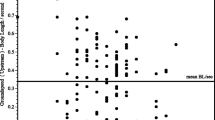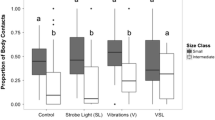Abstract
The capability of early life history stage fishes to access nursery habitat within managed salt marshes is dependent on their ability to negotiate water control structures (WCSs). Knowledge of swimming ability and hydrodynamic preferences is essential to assess the impact of WCSs on fish movement in managed marshes. These data, however, are lacking for many common estuarine fishes, and the utility of the data for the few species examined thus far is limited. We examined critical swimming speeds and derived linear relationships between fish size and swimming speed for juveniles of six common estuarine fish species of the southeast U.S. and northern Gulf of Mexico coasts. White mullet Mugil curema displayed the greatest swimming ability among these six species and was able to swim against currents ≥ 30 cm s−1 higher than the other species examined at the same size. The remaining species displayed lower critical swimming speeds and were classified into groups of moderate (pinfish Lagodon rhomboides, striped mullet Mugil cephalus) or slow (silver perch Bairdiella chrysoura, spotfin mojarra Eucinostomus argenteus, spot Leiostomus xanthurus) swimmers. Our results suggest that high-flow conditions at WCSs would likely preclude the passage of all but the largest juvenile fishes, and passage for most juveniles would occur under low-flow conditions; these flows at WCSs are dictated largely by site-specific tidal and weather conditions.

Similar content being viewed by others
References
Able KW, Fahay MP (2010) Ecology of estuarine fishes, temperate waters of the western North Atlantic. The Johns Hopkins University Press, Baltimore
Brett JR (1964) The respiratory metabolism and swimming performance of young sockeye salmon. J Fish Res Board Can 21:1183–1226
Bunt CM, Castro-Santos T, Haro A (2012) Performance of fish passage structures at upstream barriers to migration. Rivers Res Appl 28:457–478
Cowan JH Jr, Turner RE, Cahoon DR (1988) Marsh management plans in practice: do they work in coastal Louisiana, USA? Environ Manag 12(1):37–53
Doehring K, Young RG, McIntosh AR (2011) Factors affecting juvenile galaxiid fish passage at culverts. Mar Freshw Res 62:38–45
Eberhardt AL, Burdick DM, Dionne M (2011) The effects of road culverts on nekton in New England salt marshes: implications for tidal restoration. Restor Ecol 19(6):776–785
Faria AM, Ojanguren AF, Fuiman LA, Goncalves EJ (2009) Ontogeny of critical swimming speed of wild-caught and laboratory-reared red drum Sciaenops ocellatus larvae. Mar Ecol Prog Ser 384:221–230
Ficke AD, Myrick CA, Jud N (2011) The swimming and jumping ability of three small Great Plains fishes: implications for fishway designs. Trans Am Fish Soc 140:1521–1531
Fisher R, Leis JM, Clark DL, Wilson SK (2005) Critical swimming speeds of late-stage coral reef fish larvae: variation within species, among species and between locations. Mar Biol 147:1201–1212
Hartwell SI, Otto RG (1978) Swimming performance of juvenile menhaden (Brevoortia tyrannus). Trans Am Fish Soc 107(6):793–798
Hartwell SI, Otto RG (1991) Critical swimming capacity of the Atlantic silverside, Menidia menidia L. Estuaries 14(2):218–221
Herke WH, Knudsen EE, Knudsen PA, Rogers BD (1992) Effects of semi-impoundment of Louisiana marsh on fish and crustacean nursery use and export. N Am J Fish Manag 12:151–160
Hettler WF (1977) Swimming speeds of juvenile estuarine fish in a circular flume. Proc Ann Conf Southeast Assoc Fish Wildl Agencies 31:392–398
Kimball ME, Rozas LP, Boswell KM, Cowan JH (2010) Evaluating the effect of slot size and environmental variables on the passage of estuarine nekton through a water control structure. J Exp Mar Biol Ecol 395:181–190
Kimball ME, Rozas LP, Boswell KM, Cowan JH (2015) Effects of slotted water control structures on nekton movement within salt marshes. Mar Coast Fish 7:177–189
Kimball ME, Boswell KM, Rozas LP (2017) Estuarine fish behavior around slotted water control structures in a managed salt marsh. Wetl Ecol Manag 25:299–312
Knudsen PA, Herke WH, Knudsen EE (1985) Emigration of brown shrimp from a low-salinity shallow-water marsh. Proc La Acad Sci 48:30–40
Mallen-Cooper M (1992) Swimming ability of juvenile Australian bass, Macquaria novemaculeata (Steindachner), and juvenile barramundi, Lates calcarifer (Bloch), in an experimental vertical-slot fishway. Aust J Mar Freshw Res 43:823–834
Mallen-Cooper M (1994) Swimming ability of adult golden perch, Macquaria ambigua (Percichthyidae), and adult silver perch, Bidyanus bidyanus (Teraponidae), in an experimental vertical-slot fishway. Aust J Mar Freshw Res 45:191–198
McGovern JC, Wenner CA (1990) Seasonal recruitment of larval and juvenile fishes into impounded and non-impounded marshes. Wetlands 10:203–221
Mitchell CP (1989) Swimming performances of some native freshwater fishes. N Z J Mar Freshw Res 23:181–187
Montague CL, Zale AV, Percival HF (1987) Ecological effects of coastal marsh impoundments. Environ Manag 11(6):743–756
Nanami A (2007) Juvenile swimming performance of three fish species on an exposed sandy beach in Japan. J Exp Mar Biol Ecol 348:1–10
Plaut I (2001) Critical swimming speed: its ecological relevance. Comp Biochem Physiol Part A 131:41–50
Robinson KF, Jennings CA (2012) Maximizing age-0 spot export from a South Carolina estuary: an evaluation of coastal impoundment management alternatives via structured decision making. Mar Coast Fish Dyn, Manag, Ecosyst Sci 4:156–172
Robinson KF, Jennings CA (2014) Productivity of functional guilds of fishes in managed wetlands in coastal South Carolina. J Fish Wildl Manag 5:70–86
Rogers DR, Rogers BD, Herke WH (1994) Structural marsh management effects on coastal fishes and crustaceans. Environ Manag 18(3):351–369
Rulifson RA (1977) Temperature and water velocity effects on the swimming performances of young-of-the-year striped mullet (Mugil cephalus), spot (Leiostomus xanthurus), and pinfish (Lagodon rhomboides). J Fish Res Board Can 34(12):2316–2322
Rulifson RA, Wall BL (2006) Fish and blue crab passage through water control structures of a coastal bay lake. N Am J Fish Manag 26:317–326
Stevens PW (2006) Sampling fish communities in saltmarsh impoundments in the northern Indian River Lagoon, Florida: cast net and culvert trap gear testing. Fla Sci 69(2):135–147
Teodosio MA, Garel E (2015) Linking hydrodynamics and fish larvae retention in estuarine nursery areas from an ecohydrological perspective. Ecohydrol Hydrobiol 15:182–191
Underwood ZE, Myrick CA, Compton RI (2014) Comparative swimming performance of five Catostomus species and roundtail chub. N Am J Fish Manag 34:753–763
Wakeman JM, Wohlshlag DE (1982) Least-cost swimming speeds and transportation coasts in some pelagic estuarine fishes. Fish Res 1:117–127
Whitfield AK, Panfili J, Durand JD (2012) A global review of the cosmopolitan flathead mullet Mugil cephalus Linnaeus 1758 (Teleostei: Mugilidae), with emphasis on the biology, genetics, ecology and fisheries aspects of this apparent species complex. Rev Fish Biol Fish 22(3):641–681
Williams JG, Armstrong G, Katopodis C, Larinier M, Travade F (2012) Thinking like a fish: a key ingredient for development of effective fish passage facilities at river obstructions. River Res Appl 28:407–417
Wolter C, Arlinghaus R (2003) Navigation impacts on freshwater fish assemblages: the ecological relevance of swimming performance. Rev Fish Biol Fisheries 13:63–89
Wright GV, Wright RM, Bendall B, Kemp PS (2016) Impact of tide gates on the upstream movement of adult brown trout, Salmo trutta. Ecol Eng 91:495–505
Wuenschel MJ, Able KW (2008) Swimming ability of eels (Anguilla rostrata, Conger oceanicus) at estuarine ingress: contrasting patterns of cross-shelf transport? Mar Biol 154:775–786
Acknowledgements
This project was funded by the Gulf States Marine Fisheries Commission and the Louisiana Department of Wildlife & Fisheries. We thank H. Finley and R. Pausina from the Louisiana Department of Wildlife & Fisheries, as well as D. Kusher and A. Schwab from Wofford University for their assistance. Support for A. Richards was provided by the Cornell College Rogers Fellow in Environmental Studies program. This research was conducted in accordance with the guidelines set forth in the University of South Carolina IACUC Animal Care and Use Protocol #2153‐100816‐033114. The suggestions of A. Chester and two anonymous reviewers improved the manuscript. The findings, conclusions, and recommendations presented in this manuscript are those of the authors and do not necessarily represent the views of the NOAA National Marine Fisheries Service. This is contribution #70 from the Marine Education and Research Center in the Institute for Water and Environment at Florida International University.
Author information
Authors and Affiliations
Corresponding author
Rights and permissions
About this article
Cite this article
Kimball, M.E., Boswell, K.M., Rozas, L.P. et al. Swimming abilities of juvenile estuarine fishes: implications for passage at water control structures. Wetlands Ecol Manage 26, 383–390 (2018). https://doi.org/10.1007/s11273-017-9580-9
Received:
Accepted:
Published:
Issue Date:
DOI: https://doi.org/10.1007/s11273-017-9580-9




